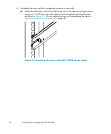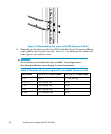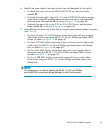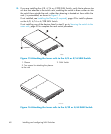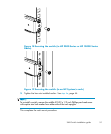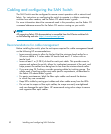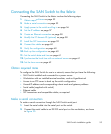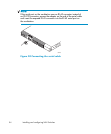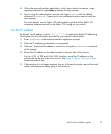
Cabling and configuring the SAN Switch
The SAN Switch must be configured to ensure correct operation with a network and
fabric. For instructions on configuring the switch to operate in a fabric containing
switches from other vendors, see the Fabric OS administrator’s guide.
For more information about the com m a nds used in this procedure, see the Fabric OS
command referenc
emanualfor the Fabric OS version running on your switch.
NOTE:
All supporting Fabric OS documentation is acc essible from the B-Series switches link
on the following web site: h
ttp://www.hp.com/go/san.
Recommendations for cable management
Before installing the switch, plan the rack space required for cable management based
on the following HP recommendations:
• Leave enough space to allow for the fact that the minimum bend radius for a
50-micron cable is 2 inch es under full tensile load and 1.2 inches with no
tensile load.
• Leave at least 1 m (3.28 ft) of slack for each port cable. This provides room to
remove and replace the switch, allows for inadvertent movement of the rack, and
helps prevent the c ables from being bent to less than the minimum bend radius.
• If you are using ISL Trunking, consider grouping cables by trunking groups. The
cables used in trunking groups must meet specific requirements, as described in
the Fabric OS administrator’s guide.
• For easier maintenance, label the fiber optic cables and record the devices
to which they are connected.
• Keep LEDs visible by routing port cables and other cables away from the LEDs.
• Do not use tie wraps on fiber optic cables; tie wraps are easily overtightened
and can damage the optic fibers. HP recommends using velcro straps to secure
and organize fiber optic cables.
52
Installing and configuring SAN Switches



